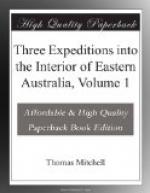MR. WHITE CROSSES THE RIVER.
This day Mr. White crossed the river and examined the country for several miles beyond it, in search of the pine (or callitris) which we required for the completion of our boat, but he found none in that direction.
MARKS OF FLOODS ON TREES.
About three miles to the north of our camp he came upon a chain of large lagoons extending in a westerly direction, and the drift marks on trees showed that at some seasons a considerable current of water flowed there to the westward, rising occasionally to the height of ten or twelve feet above the surface of these lagoons. He also saw a kangaroo, a circumstance which indicated that higher forest land was not far distant. Thermometer at six A.M. 67 degrees. Wind North-East high. Sky clear. At noon thermometer 87, clear sky.
We now looked with some anxiety for Mr. Finch’s arrival and, in order to preserve our provisions as long as possible, I determined to make the abundance of fish available, by distributing fishing-hooks to the men, and to reduce their weekly ration of pork from 3 1/2 to 2 pounds.
In fishing we were tolerably successful; but flour was the article of which we stood most in need, and for this the country afforded no substitute, although I reduced the allowance of that also. The only starving members of the party were our unfortunate dogs, which had become almost too weak to kill a kangaroo—had any been seen there; neither did that region contain bandicoots which, in other situations, had been occasionally caught about dead trees, with the assistance of some of the watch-dogs. We were obliged to shoot hawks and crows, and boil them into a mess, which served, at least, to keep these poor animals alive.
January 29.
The cart was sent back about twelve miles for some of the callitris trees required for planking, none having been seen nearer to our camp.
MAN LOST IN THE WOODS.
William Woods, who had gone out in search of the spare cattle early in the morning, did not return by one P.M., and as he was a good bushman, we began to feel apprehensive that the natives had detained or perhaps killed him. I therefore proceeded in search with four men, and scoured the forest within five miles of the camp without discovering any traces either of the natives or of him. On returning however at sunset, we had the satisfaction to find that he had reached the camp about an hour before us, having during the whole day been unable to find his way back to our camp through the trackless forest.
Today the river fell another inch, and this failure of the waters, as upon the Namoi, added much to the irksomeness of the delay necessary for the completion of a boat. In the present case however more than on the Namoi, the expected arrival of Mr. Finch, and the exhausted state of our cattle, disposed me to give the party some days rest at so convenient a point, and towards which I had indeed looked forward with




